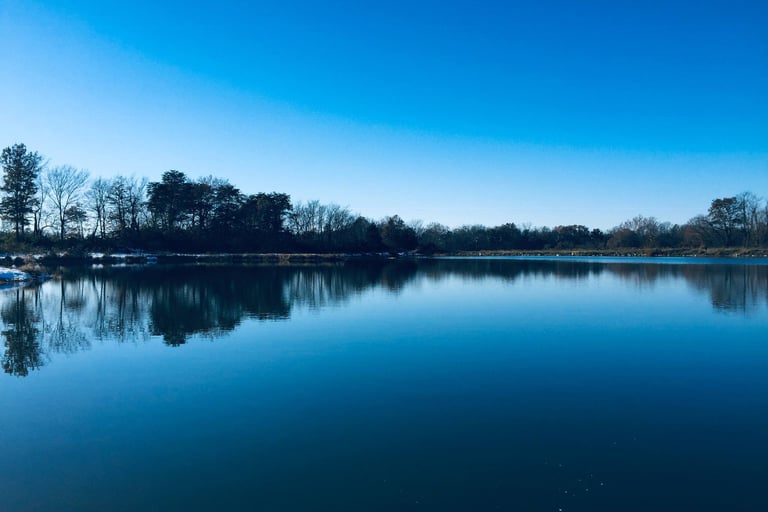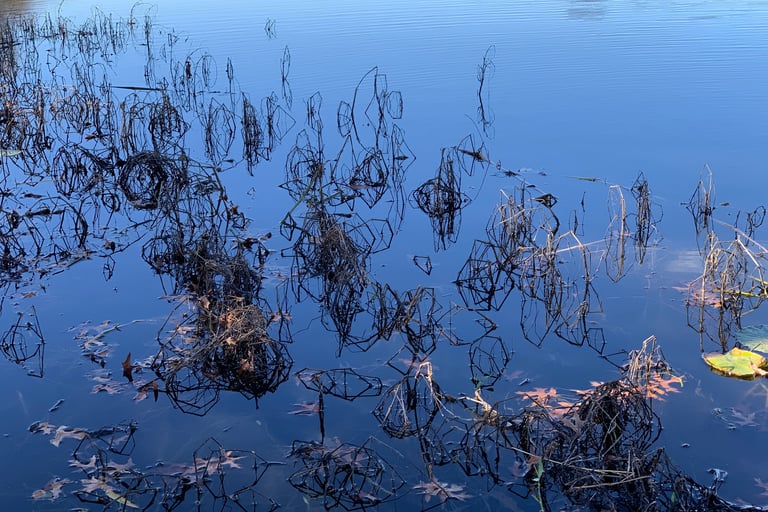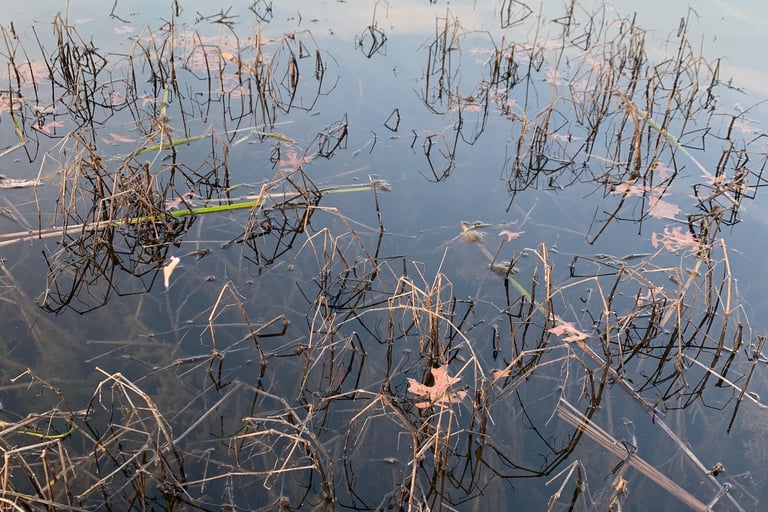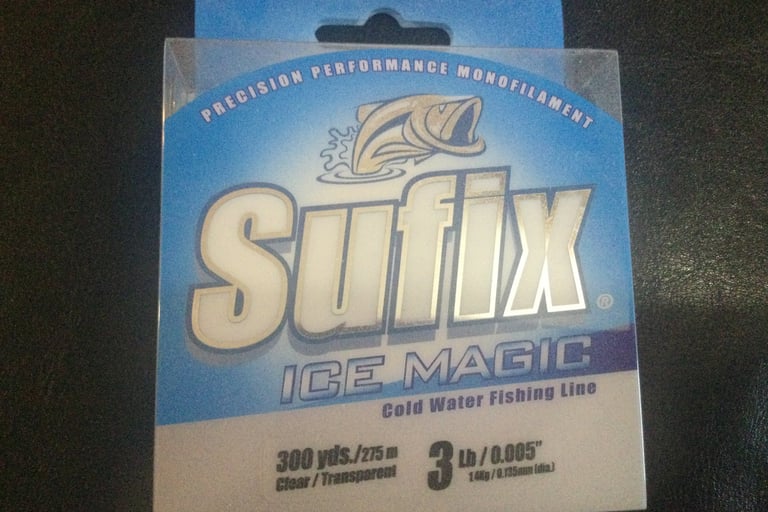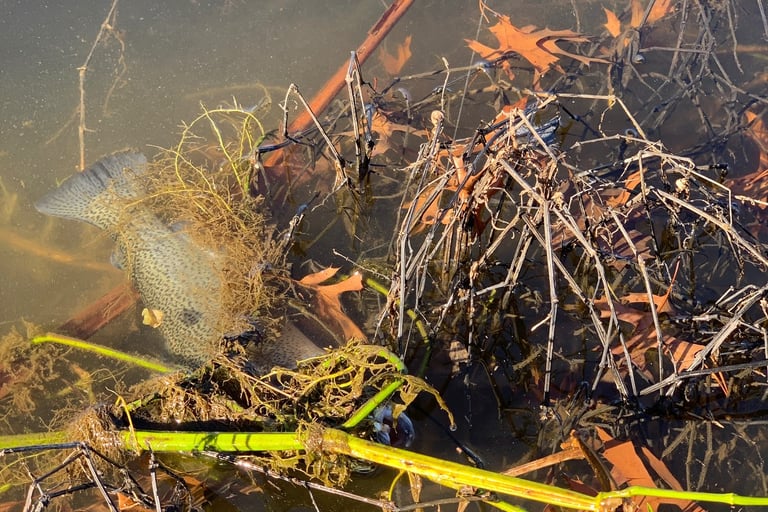Good Fishing Isn’t Easy Fishing
Lessons about life, on the water.
1/25/20256 min read


The evolution from “reasonable fishing” to “difficult to fish” of a lake in just five years.
I didn’t know how trout related to still water lake structure. I know every nook and cranny (and seam, flow and backwater) they frequent in streams and rivers. One of the catch and release trout lakes I fish has always been “not like” waters that I at least, thought of as “trout water”. The lake has many brush piles, and aquatic weeds initially lined the shallow to medium depth waters of about 1/3 the lake. Aquatic weeds that have stalks more like soft wood, and roots that grow to the center of the earth-if you hook one with your jig or whatever lure you may choose-you aren’t getting it back unless you can wade to it and do forestry work.
Introduce the drought conditions of the last approximate three years, and the weeds now consume 75% of the shoreline, and sometimes even into deep water. By last year, I didn’t fish it save for a couple of times with no recall of good fishing, those trips. I wondered if the state would even stock the lake, this year. They did…
…so I probably spent many sleepless hours many nights (really 😵💫) figuring out how I could get to those trout. Well of course I figured it out fairly quick, but what a hassle. Some first options were confidence breakers. Using line heavier than 4 lb test for trout (or anything panfish)-is a confidence breaker. The fish can be crawling up my line, rod, and finally my elbow but if I don’t have confidence, I’m not gonna catch ‘em. 😟 I’ve learned that trout love getting deep into the thickest weeds and brush on these still water lakes. Like crappie. 🤦🏻♂️ A calm morning/day a specific group or line of weeds start moving. Kind of a ghostly experience. But it’s those trout. 😲 “Dipping” a jig in four inch holes of water between weeds is an infinite process to finally and blindly “land on one.” 😩 Using a rod longer than five feet definitely provides more leverage to do everything I have to do to get trout through, or up and over those weeds. But beyond a five foot rod the jig loses my signature effect. So here’s what I came up with. And it works. Like 500% beyond my expectations.
By accident, I found that many cheaper rods have a little more muscle due to an inferior mix of materials when compared to some of the space aged carbons and graphites used in more expensive rods. Sufix Ice Magic, a line for ice fishing that I use year round up to now for three reasons-line diameter is .001 mm smaller than other lines of the same weight which for me translates more to how much farther I can cast a jig that many would only cast with a fly rod; I can get ice line in that odd 3 lb test line, a perfect compromise when I find conditions breaking 2 lb line, and my confidence not supporting 4 lb line; and ice line is treated to be more abrasion resistant than average mono lines since ice fishing requires constantly dragging fish over the sharp edge of a hole in the ice. In other words, Sufix ice line is strong. But was it strong enough to support what I was about to do?
Next issue-the weeds. I calculated that what I was about to attempt would work only a certain distance “through the weeds”. I’ve never liked waders. Something about “all of that going on” above my waist and I’ve avoided wearing them except in cold weather. Trying to overcome so many reasons I wasn’t going to like trying for these trout in the flooded forest, it occurred to me that waist waders may be the answer. Something I never tried and honestly, never thought about trying. 🤷🏻♂️ What cinched the deal was my reading a review, “…and at my age, I don’t have any business trying to wade in water almost to my neck.” Well, that certainly fit my profile! In fact I’m the guy that, if I’m wearing waders 60 inches tall, I’m going to wade into water 61 inches deep and just stand on my tip toes.
Strategy and gear in place, I set out to turn this lake back into the great trout fishery that it’s been. Though it still was I’m sure, from the trout’s perspective, nature and possibly a bit of not managing the waterways well by those responsible, had separated me from that good trout fishing. Strategy: 1. Wade out to the front of the weed lines-or at least as far as I could get with waist high protectionI. 2. Set reel drag tighter than usual. A tightrope walk between not letting a trout run, and the trout breaking 3 lb. test line when it tried to run, or I air mailed each to the net at my side. 3. “High stick”. Sticking the rod tip to the sky or maybe even behind you a bit when fighting a fish. A “no-no” because simply stated, it results in many broken rods over a lifetime. But high sticking thus muscling and even launching these trout airborne once caught, was about my only chance in these conditions.
Each new day, I often missed landing the first one or two trout because the high sticking had to be at a new level. That is, including extending my arms as far as I could above my head, rod in hand, fighting trout on rod. It’s so unnatural I defaulted to the “just wrong” high sticking, where your wrists remain in proximity to your chest. Every catch, every high stick, every muscle in, I waited for the snap sound of a broken rod. But knowing the cheaper rod actually had a little more strength to be treated more as an inexperienced fisherman may treat it, as well as it was “cheaper”, worry would fade with the first few attempts of the hooked trout to make my day a mess. “I’ll just replace the rod.”
I often find myself panting or out of breath and with aches and pains in places not usually sounding off simply fishing. The effort to get to, hook, and then land these trout on a very non-trout like lake, is more like a pick-up game of basketball.
Honestly, there have been a few days that I went to the more trout-like lake when a trip had been planned to this lake. Kind of like planning to practice three days in a row for a running marathon, but you may instead just go for brisk walk on flat ground the third day-you’re spent.
And so it goes, I have story after story following the same work to have fun, ethic. One of my best crappie fishing adventures was over the creek, up the bluff, down a hillside, and into the trees, standing in water. Fishing until after dark, the crappie were so thick. Giggly thick. Early March, one year. So I wasn’t dressed for how quickly the environment changed as the sun set. Of course it was a little dicey backtracking that route-after dark!
So, while I’ll sometimes check the “walk a few steps from the vehicle” spots, I can count on two hands (with not all fingers being used) how many times that’s worked out for “good fishing”, in my life. Did standing waist high in 40-45 degree water, slogging through then standing aquatic weeds, and getting breathless per fish just trying to get the dang thing to my net, pay off? Well yeh...it did. Ten, 15-20 trout per hour for the 3-4 hours I could last! Good fishing…isn’t easy.
